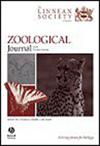Breaking through the eggshell: embryonic development of the premaxillary dentition in Lacerta agilis (Squamata: Unidentata) with special emphasis on the egg tooth
IF 3
2区 生物学
Q1 ZOOLOGY
引用次数: 0
Abstract
The egg tooth of squamates is a true tooth that allows them to break, tear, or cut the eggshell during hatching. In this clade there are some uncertainties concerning the egg tooth implantation geometry, the number of germs, and their fates during embryonic development. Here, we used X-ray microtomography and light microscopy, focusing on the egg tooth and remaining premaxillary teeth of the sand lizard (Lacerta agilis, Squamata: Unidentata). The developing egg tooth of this species passes through all the classic stages of tooth development. We did not find any evidence that the large size of the egg tooth is related to the merging of two egg tooth germs, which has recently been suggested to occur in snakes. Instead, this feature can be attributed to the delayed formation of the neighbouring regular premaxillary teeth. This might provide more resources to the developing egg tooth. At the last developmental stage, the egg tooth is a large, midline structure, bent forward as in most oviparous Unidentata. It is characterized by pleurodont implantation, and its base is attached to the pleura and a peculiar ridge of the alveolar bone. The attachment tissue contains periodontal ligament-like tissue, acellular cementum-like tissue, and alveolar bone.突破蛋壳:Lacerta agilis(有鳞类:单体动物)前下颌牙齿的胚胎发育,特别强调卵齿
有鳞类的卵齿是一种真正的牙齿,可以让它们在孵化过程中打破、撕裂或切割蛋壳。在该类群中,关于卵齿植入的几何形状、胚芽数量及其在胚胎发育过程中的命运还存在一些不确定性。在这里,我们使用了 X 射线显微层析技术和光学显微镜,重点研究了沙蜥(Lacerta agilis,有鳞目:单齿蜥科)的卵齿和剩余的前颌齿。该物种正在发育的卵齿经历了牙齿发育的所有典型阶段。我们没有发现任何证据表明,卵齿的大尺寸与两个卵齿胚芽的合并有关,而最近有人认为蛇类也会出现这种情况。相反,这一特征可归因于邻近的常规前颌牙齿的延迟形成。这可能为发育中的卵齿提供了更多的资源。在最后一个发育阶段,卵齿是一个巨大的中线结构,与大多数卵生单齿类动物一样向前弯曲。它的特点是胸膜种植,其基部附着在胸膜和牙槽骨的一个特殊脊上。附着组织包括牙周韧带样组织、无细胞骨水泥样组织和牙槽骨。
本文章由计算机程序翻译,如有差异,请以英文原文为准。
求助全文
约1分钟内获得全文
求助全文
来源期刊
CiteScore
6.50
自引率
10.70%
发文量
116
审稿时长
6-12 weeks
期刊介绍:
The Zoological Journal of the Linnean Society publishes papers on systematic and evolutionary zoology and comparative, functional and other studies where relevant to these areas. Studies of extinct as well as living animals are included. Reviews are also published; these may be invited by the Editorial Board, but uninvited reviews may also be considered. The Zoological Journal also has a wide circulation amongst zoologists and although narrowly specialized papers are not excluded, potential authors should bear that readership in mind.

 求助内容:
求助内容: 应助结果提醒方式:
应助结果提醒方式:


